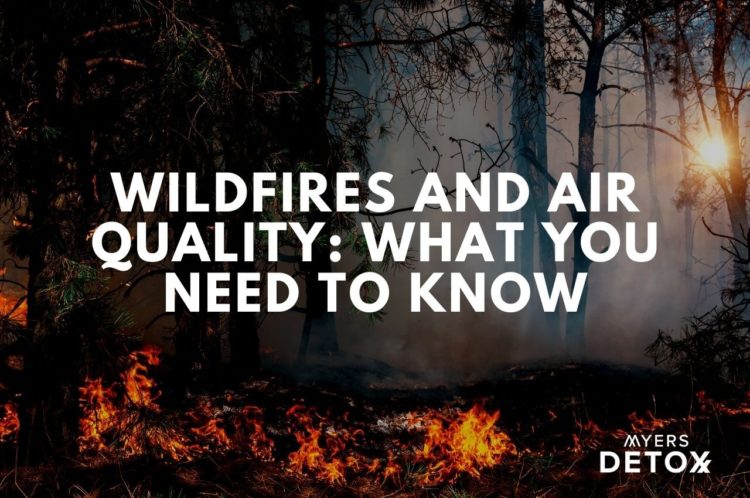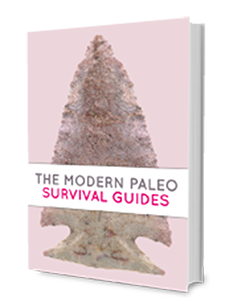Wildfires And Air Quality: What You Need To Know

Wildfires have been taking over the news lately, and with no end in sight. The heartbreaking images of people fleeing their homes, leaving behind the wreckage, have become what seems like a daily occurrence.
Although it may be difficult to watch, these news stories serve as an important reminder of what is happening to our air quality.
Even if you don’t live in an area that’s experiencing wildfires, the toxic emissions that they release may still be reaching you. In fact, large wildfires can increase air pollution over thousands of square miles[1].
For this reason, it’s crucial that you take steps to protect yourself and your family from the possible health detriments of poor air quality that result from these fires.
The Dangers Of Air Quality From Wildfires
The smoke from wildfires contains a large range of pollutants, and these hazardous chemicals pose serious health risks. The particulate matter that pollutes the air after wildfires is a mix of very tiny liquid and solid particles that are suspended in the air. These tiny particles are about ⅓ the size of the diameter of your hair, which means that they can enter and lodge deep into your lungs.
Particle pollution can trigger a range of lung conditions, including asthma attacks, heart attacks, and stroke[2].
This particle pollution is made up of a wide range of chemicals, including acids, inorganic compounds, organic chemicals, soot, metals, dust, and biologic materials like pollen and mold.
Some of the most concerning compounds affecting air quality from wildfires include:
- Carbon Monoxide
- Pesticides
- Heavy Metals
- Formaldehyde
Let’s go over these in detail:
Carbon Monoxide
Carbon monoxide is another common toxin found in wildfire smoke. This colorless, odorless gas reduces oxygen delivery to the tissues and organs in your body and can result in headaches, dizziness, nausea, and even death[2].
Pesticides
Pesticides that are used on land affected by wildfires can become volatile — meaning their vapors can move through the air. These vapors can directly impact air quality, and also contribute to the formation of ground-level ozone[3].
Ozone occurs naturally in the upper atmosphere, but it can become a harmful air pollutant when it reaches ground-level. Breathing in ozone can trigger throat irritation, chest pain, coughing, airway inflammation, and can worsen conditions like bronchitis, emphysema, and asthma[4].
Heavy Metals
Heavy metals are another common pollutant that can impact air quality from wildfires. Depending on the source of smoke, metals, including cadmium, mercury, lead, aluminum, and chromium, could be contaminating the air you breathe.
After a fire, heavy metals from the ash can also go on to contaminate soil and waterways[5][6].
Heavy metals can enter your body and dysregulate the function of your cells and tissues, leading to a range of health consequences. Some of the health risks associated with breathing in heavy metals include[7]:
- Production of reactive oxygen species (leading to oxidative stress in the airways and central nervous system)
- Reduced lung function and the onset of respiratory diseases like asthma
- Respiratory infections
- Changes in heart rate, blood pressure, and blood clotting
- Genotoxicity (damage to DNA)
- Neurotoxicity (inflammation in the brain and accumulation of metals in brain tissue)
Nitrogen Dioxide
Nitrogen dioxide is a gaseous air pollutant composed of nitrogen and oxygen that’s formed when wood or fossil fuels are burned. This is another dangerous compound that can produce ground-level ozone.
When you breathe in nitrogen dioxide, it can create a range of harmful effects on your lungs, including inflammation in the airways, cough or wheezing, asthma attacks, and overall reduced lung function. Beyond lung health, nitrogen dioxide may also impact cardiovascular health and reproductive health[8].
Formaldehyde
Formaldehyde is released into the air from wildfires due to its natural presence in plants. It’s also a well-known air pollutant due to industrial emissions, incineration, and fuel combustion[9].
The harmful health effects of formaldehyde are wide-ranging. Some airborne formaldehyde health concerns include[10]:
- Burning, stinging eyes
- Wheezing
- Chest tightness
- Headaches
- Irritation and dryness of the nose and throat
- Disturbed sleep
- Excessive thirst
- Nervous system dysfunction (dizziness, inability to concentrate, weakness, apathy)
How To Protect Yourself From Wildfire Smoke
Stay Inside When Possible
This may seem obvious, but if the air quality is really bad, this is not a time for outdoor activities. Although it can be incredibly healing to walk by the ocean or in the forest, the determinants outweigh the benefits when the air quality is low. Find ways to move your body inside like doing yoga, stretching, or take an aerobics class online.
Also, make sure your windows and doors are closed as the outside air could seep in and contaminate your indoor air quality.
Turn Central Air Conditioning and Heating “On”
If you have central air in your home, make sure that it is set to the “on” function as opposed to “auto.” When it’s set to “on,” it will continuously move the air, as opposed to intermittently with the auto function. Also, be sure that your home is equipped with high-efficiency air filters that capture fine particles from smoke.
Use An Air Filter In Your Home
Air filters can help clear your home of common toxic air pollutants like mold, dust, formaldehyde, and pathogens. When there is smoke from wildfires in the air, using a high-quality air filter can give you peace of mind that at least one room in your home is being recirculated with clean air.
If you only have one air filter, then designate that room for sleeping, exercise, and any leisure activity you can. The goal is to bathe yourself in clean air as much as possible.
I use a filter from Purewarepureair.com to filter particulates in the air. The owner Terry Wright is the single most knowledgeable person on air filtration I’ve ever met. He’s been in the air filter business 40 years. Call him and he’ll find that filter that meets your needs. He’s very generous with his time and knowledge.
Wear A Respirator Mask
While there are many different types of masks out there, a respirator mask like an N95 or P100 will offer the most protection against wildfire pollutants. It’s designed to help protect you from inhaling hazardous compounds like fumes, vapors, gasses, particulate matter, and mold.
Avoid Burning Anything In Your Home
You won’t be opening your windows or doors when the air quality outside is poor, so keeping your indoor air quality as pure as possible is crucial. Avoid burning candles, using your fireplace, using gas, propane, or wood-burning stoves inside, and spraying aerosol of any kind.
Soothe Your Lungs With Essential Oils
One simple way to soothe your lungs is to inhale essential oils. Eucalyptus, in particular, has been found to have an anti-inflammatory effect on lung tissue[11].
Simply add a few drops of eucalyptus oil to hot water and inhale the steam for five to ten minutes. You can also add a few drops to your bath or shower.
Support Your Body
Taking preventative measures to avoid smoke from wildfires is crucial. However, even with the utmost precaution, avoiding the pollutants from poor air quality altogether is nearly impossible. That’s where nutrients that support your body’s detox pathways come in.
Some of the most powerful superfoods and herbs that you can include in your diet to promote healthy liver and detoxification systems include:
- Broccoli sprouts contain a compound called sulforaphane, which enhances the antioxidant and detoxification activity in your body. Research shows that broccoli sprouts can assist in the detoxification of airborne pollutants, with one clinical trial showing a 61% improvement in air pollutant removal[12].
- Beets are both anti-inflammatory and antioxidant. What’s more, research shows that the nutrients in beets can support phase 2 detoxification — a crucial step in removing harmful compounds from your body[13].
- Turmeric has been used for thousands of years in traditional systems of medicine like Ayurveda. This spice has recently gained a lot of attention as researchers continue to uncover the many benefits that it has to offer. Curcumin, one of the bioactive compounds found in turmeric, has been specifically studied for its antioxidant and detoxification effects. More specifically, it appears that curcumin may assist your body in processing heavy metals like mercury and lead[14][15].
- Milk thistle has an affinity for specific organs and tissues. It’s well known to be liver supportive through its antioxidant and anti-inflammatory activity, as well as its ability to assistant in the regeneration of liver cells[16][17].
- Moringa is another plant that has been found to promote liver health. This incredibly nutrient dense plant is rich in a myriad of vitamins and minerals and is also a rich source of pro liver antioxidants like quercetin, gallic acid, and caffeic acid[18].
A Simple Way To Promote Lung Health, Liver Health and Detoxification
Any action you can take to support your lung health will always make a difference, and stressing about anything always does more harm than good.
Taking precautions, like the few tips I mention in this article, in your home is an important step, but caring for your body with targeted nutrients is just as vital.
When it comes to air pollution or pollutants of any kind, I always look to liver supportive nutrients like those mentioned above. Whatever your lungs breathe in, the liver is tasked to detox them. So the liver needs critical support, during fire season especially. My personal opinion is that caring for your liver should be a daily practice, and it shouldn’t take much time.
That’s why I created Daily Detox. This powdered supplement is packed with nutrient dense foods and herbs that are research-backed to support and maintain your body’s natural detoxification processes.
Daily Detox not only includes nutrients that assist your body in doing its job with detoxification, but it also has a fiber blend, metabolic support blend, and a greens blend.
If you have 30 seconds a day, you have time to incorporate Daily Detox into your healthy routine.
Click Here for References+
-
Pereira, Paulo, and Xavier Úbeda. “Spatial distribution of heavy metals released from ashes after a wildfire.” Journal of Environmental Engineering and Landscape Management 18.1 (2010): 13-22.
-
https://www.lung.org/clean-air/outdoors/what-makes-air-unhealthy/toxic-air-pollutants
-
Fortoul, T. I., et al. “Health effects of metals in particulate matter.” Current air quality issues. IntechOpen, 2015.
-
https://www.lung.org/clean-air/outdoors/what-makes-air-unhealthy/nitrogen-dioxide
-
Wang, Lin, et al. “Protective effect of eucalyptus oil against pulmonary destruction and inflammation in COPD rats.” J Dis Med Plts 3 (2017): 17-22.
-
Egner, Patricia A., et al. “Rapid and sustainable detoxication of airborne pollutants by broccoli sprout beverage: results of a randomized clinical trial in China.” Cancer prevention research 7.8 (2014): 813-823.
-
Clifford, Tom, et al. “The potential benefits of red beetroot supplementation in health and disease.” Nutrients 7.4 (2015): 2801-2822.
-
Mailafiya, Maryam Muhammad, et al. “Curcumin-loaded cockle shell-derived calcium carbonate nanoparticles: A novel strategy for the treatment of lead-induced hepato-renal toxicity in rats.” Saudi Journal of Biological Sciences (2020).
-
Agarwal, Rakhi, Sudhir K. Goel, and Jai Raj Behari. “Detoxification and antioxidant effects of curcumin in rats experimentally exposed to mercury.” Journal of Applied Toxicology 30.5 (2010): 457-468.
-
Mulrow, C., et al. “Milk thistle: effects on liver disease and cirrhosis and clinical adverse effects: summary.” AHRQ Evidence Report Summaries. Agency for Healthcare Research and Quality (US), 2000.
-
Vargas-Mendoza, Nancy, et al. “Hepatoprotective effect of silymarin.” World journal of hepatology 6.3 (2014): 144.
-
Asgari-Kafrani, A., M. Fazilati, and H. Nazem. “Hepatoprotective and antioxidant activity of aerial parts of Moringa oleifera in prevention of non-alcoholic fatty liver disease in Wistar rats.” South African Journal of Botany 129 (2020): 82-90.








